Living in an Age-Friendly Community: Evidence from a Masterplanned Development in Southwest Sydney
Abstract
1. Introduction
2. Materials and Methods
2.1. Park Central
- It being situated in close proximity to a range of amenities—including healthcare facilities (esp. Campbelltown Hospital), two very local shopping centres (Macarthur Square and Marketfair Campbelltown), social infrastructure (esp. the Campbelltown Catholic Club) and a public transport hub (esp. Macarthur Railway Station)—identified as important features of age-friendly communities [58];
- The provision, within the development itself, of a “[d]iverse housing mix catering to different lifestyles and age groups” (p. 2, [59]) in order to “retain local residents as their housing needs change” (p. 14, [56]). This dwelling mix comprises apartments, terraced homes, live/work spaces, small lot homes (‘garden homes’), as well as IRT Macarthur (a co-located retirement village and residential aged care centre comprising 262 self-contained independent living apartments in varying configurations and a 60-bed assisted care facility [60]);
- The provision of a range of shared and community facilities within the development itself, including service retail, cafes/restaurants, and the 10.5 ha landscaped open greenspace ‘Marsden Park’ (which, from an age-friendly perspective, is importantly a contained park located in the centre of the development (p. 9, [16]));
- Some attempts within the development itself to create a “walkable community within the context of the ‘car dependant’ south western Sydney region” (p. 14, [56]). These included, for instance, the inclusion of dedicated footpaths linking residential streets in the development (Figure 2), and of some ‘shared space’ residential streets [61] connecting the development to the wider urban area (Figure 3).
2.2. Data Collection and Analysis
3. Results
3.1. Environmental Affordances of Age-Friendly Communities
[W]e’ve got all the medical facilities we need here, three shopping centres in the local area, and a nice place to go and walk if you need to walk.
I find it pretty easy [Living in Park Central] actually because it’s all easy access to the shops and everything, everything is close by, shop, train station. It’s friendly to have neighbours everywhere and yes, it’s very convenient.
Basically, it’s close to everything, close to transport, to the shops, to the public hospital; basically, everything is within walking distance, which is what really appealed to us.
The other main reason for doing it [moving to Park Central] is if someone can’t drive one day or were injured, we’ve got all the medical facilities we need here, three shopping centres in the local area, and a nice place to go and walk if you need to walk.
[A] lot of people couldn’t believe that we were buying a house with stairs. But I always said we’ve always got a bedroom downstairs if that’s what we needed, and it’s a big ensuite, a big toilet, shower, basin so you coud take a wheelchair in there if you wanted to.
The village units are built, all of them with doors either a metre or very close to a metre wide, to have facility for access by wheelchairs. …In the unit, everywhere is accessible by wheelchair, including the bathroom. The bathroom was built with handrails down the side of the toilet, grab rails in the shower. The shower is big enough to shower three or four people. There is nothing to step over into the shower, you can walk straight in.
Sustainability, from my way of thinking in the sense that …the better the house was built for the older person, the longer the person can stay in there at no additional cost to the government. That’s my way of thinking, a part of sustainability.
- the gradient of the streets between Park Central and the shopping centre (with one street referred to as ‘Heartbreak Hill’ on account of its steepness);
- the lack of designated crossings on busy routes within Park Central, and the density and speed of traffic on those routes, some of which had become local ‘rat runs’;
- the lack of visibility for crossing those busy routes (in particular caused by cars parked tightly on both sides of the road (Figure 4));
- a lack of dropped kerbs for crossing roads (for instance when travelling in a wheelchair or by mobility scooter, or with a pram, buggy or shopping trolley);
- those dropped kerbs that are provided being experienced as too steeply inclined to be used without tipping over by motorised wheelchair users;
- the perceived inhospitableness of some the designated crossings over arterial roads that separate Park Central from the local shopping centre (in particular in terms of the width of these crossings (Figure 5) and the short duration of their pedestrian signal phases);
- the lack of pavements on one side of the road in parts of Park Central (Figure 6);
- and regular instances of pavement parking (resulting in blocked walkways) on some streets in Park Central (Figure 7).
This is one of the worst [roads to cross] right here, it’s near a hospital and there are sick people going across to the park all the time and they’re slow, but the cars come flying. It’s a bit dicey.
With the private hospital, they need a pedestrian crossing there. People coming from the park area into the private hospital, they’ve got to negotiate the narrow street with the cars moving all the time. …It’s difficult for people to see if they’ve got bad eyesight or if they’re on crutches, or whatever it might be. …You see ladies with prams and two little kids and I’ll tell you, the cars don’t stop for them, and there are a lot of little kids over that new area, you see them in the park. Someone’s going to get skittled.
Most of the [traffic] lights [at crossings]…favour the main road. …[N]ot [allowing] sufficient [time to cross] for some people. Especially for some of our residents with walkers and that, because if you walk with them, it is very slow. I wouldn’t like to stop there, but there is another [traffic light] button [on the island] in the middle [of the crossing].
You get halfway across and you’ve got to hurry up. That’s always been a problem around here. …You know what it is, that openness [see Figure 5]. Even these lights and the lights on the corner, you feel like everyone’s looking at you, that it’s odd to walk across.
3.2. Facilitating Age-Friendly Communities
[I]n the early years [of the development], Landcom had a thing going where, in conjunction with Uniting Church, they held various functions for all residents, both in the retirement village and Park Central. And through that, there was interaction, like Mothers’ Day, Fathers’ Day, different functions, going down to Canberra for the Floriade, but that’s now ceased, the funding has stopped.
- distributed, with voluntary assistance from residents, newsletters communicating upcoming community events and activities in and around Park Central;
- organised an open-air movie night in Park Central;
- ran workshops for Park Central residents—e.g., a ‘Going Potty’ workshop (to show residents how they can grow vegetables and small fruit in pots on their balconies) and a Christmas craft-making workshop;
- set-up and coordinated a working group to try and establish a community garden in Park Central;
- helped facilitate and promote a multi-week ‘Living Smart’ course designed to provide participating Park Central residents “with the practical knowledge and skills to take action in their own homes and around the community” (p. 1, [72]). An explicit objective of this course was “[s]upporting and strengthening community relationships” to enable residents “to embrace a connected approach to living, so that long lasting solutions for a quality life now and into the future can be created” (p. 1, [72]).
[T]hey [non-retirement village Park Central residents] do support us when we have things on. When had our White Elephant stall, there was a lot from over there, because they think we’ve got good stuff, see!
The things that Sophie [the Community Development Facilitator] arranged, like mother daycare and so on, if it came that they were [taking place] here [in the retirement village] and couples were sitting beside you, they would talk and if the rapport was there and the friendship was…. That’s exactly what happened with us on the bus trip [that Sophie organised].
I think it [the Facilitator’s Community Development work] does help. What she was doing was trying to bring this into a community.
3.3. The Social Production of Age-Friendly Communities
[T]he first eight residents in [the retirement village] decided they needed to coordinate. They set up what they called a coordinating committee or some such thing. By the time we had 60 or 70 people in there [the retirement village], and that was only a matter of three months and that’s when we came in, they decided they needed to formalise it. We had a meeting of those 60 or 70 people and they agreed to have a Residents’ Committee. They elected eight people to be the Residents’ Committee and that committee set up a constitution … So then we had a Residents’ Committee who had a chairperson, secretary and treasurer and six other members and they’re elected annually.
- -
- Suitably qualified retirement village residents organising and operating, voluntarily, a weekly bus service from the retirement village to the local shopping centres, thereby enabling residents whose access to those shops was constrained or impeded (see Section 3.1) to circumscribe some of those constraints or impediments. This service was enabled by IRT conditionally permitting self-care residents to use the retirement village bus, though this required residents to volunteer as drivers for any social trips they wanted to organise. In addition to the weekly shopping service, residents also organised and operated other regular social outings using the IRT-supplied bus.
- -
- Residents petitioning, albeit unsuccessfully, for the provision of a ‘high care’ unit in the vicinity of the retirement village.
- -
- Residents working for local community organisations in the wider local area and sitting on local area committees—e.g., one research participant reported how she volunteered with the local RSL club and chaired the local Senior Issues Group which reports to Campbelltown City Council.
- -
- The organisation of 3–4 ‘block parties’ a year to enable residents on each block to socialise with one another.
- -
- A group of residents organising a group visit to a former resident who had recently been moved to a high care facility that was not local to the retirement village.
A Councillor came to look at it one day to see how bad it was and […] an engineer from the Council, and I arranged for it to be very busy that day. But eventually it [the crossing] went in and it’s been used every day.
4. Conclusions
is essentially descriptive. It provides considerable detail about…a range of approaches to fostering age-friendly communities—in terms of models of governance—and a range of outcomes regarded as age-friendly in terms of both physical and social characteristics. However, there has been limited documentation of the effectiveness of specific approaches or evaluation of the impact of specific processes or outcomes on older people’s lives.(p. 118, [5])
- -
- The observation that community activities were often scheduled during work hours, thereby systematically excluding people of working age. Should a community facilitation approach be adopted elsewhere, therefore, care should be taken about when events are scheduled to take place, as well as who they are organised for.
- -
- A concern (reported by one research participant) about the Community Development Facilitator working for an agency of a religious organisation (Uniting Church Australia). For the research participant, such an affiliation is “going to exclude people straight away”.
- -
- A communication strategy—which primarily comprised distributing newsletters to residents setting out upcoming community events—that was not always effective, with one research participant who was unaware of the activities organised by the Community Development Facilitator describing how “junk mail…just goes straight in the bin”.
- -
- The Community Development Facilitator being unable to secure from the developer a piece of enclosable land on which to plant a community garden (a type of intervention that has been shown to have numerous significant active aging benefits [78]).
Author Contributions
Funding
Informed Consent Statement
Data Availability Statement
Conflicts of Interest
References
- Lewis, C.; Buffell, T. Aging in place and the places of aging: A longitudinal study. J. Aging Stud. 2020, 54, 100870. [Google Scholar] [CrossRef]
- Menec, V.H.; Means, R.; Keating, N.; Parkhurst, G.; Eales, J. Conceptualizing Age-Friendly Communities. Can. J. Aging 2011, 30, 479–493. [Google Scholar] [CrossRef]
- Settertsen, R.A.; Angel, J. (Eds.) Developing Age-Friendly Communities: New Approaches to Growing Old in Urban Environments. In Handbook of Sociology of Aging. Handbooks of Sociology and Social Research; Springer: New York, NY, USA, 2011; pp. 279–293. [Google Scholar]
- Buffel, T.; Handler, S.; Phillipson, C. Age-Friendly Cities and Communities: A Global Perspective; Policy Press: Bristol, UK, 2018. [Google Scholar]
- Lui, C.-W.; Everingham, J.-A.; Warburton, J.; Cuthill, M.; Bartlett, H. What makes a community age-friendly: A review of international literature. Australas. J. Ageing 2009, 28, 116–121. [Google Scholar] [CrossRef]
- World Health Organization. Global Age-Friendly Cities: A Guide; World Health Organization: Geneva, Switzerland, 2007.
- Woolrych, R.; Sixsmith, J.; Duvvuru, J.; Portella, A.; Fang, M.L.; Menezes, D.; Henderson, J.; Fisher, J.; Lawthom, R. Cross-National Perspectives on Aging and Place: Implications for Age-Friendly Cities and Communities. Gerontologist 2022, 62, 119–129. [Google Scholar] [CrossRef]
- Alley, D.; Liebig, P.; Pynoos, J.; Banerjee, T.; Choi, I.H. Creating Elder-Friendly Communities: Preparations for an Aging Society. J. Gerontol. Soc. Work. 2007, 49, 1–18. [Google Scholar] [CrossRef]
- Chippendale, T.L.; Bear-Lehman, J. Enabling “aging in place” for urban dwelling seniors: An adaptive or remedial approach. Phys. Occup. Ther. Geriatr. 2010, 28, 57–62. [Google Scholar] [CrossRef]
- OECD. Ageing, Housing and Urban Development; OECD: Paris, France, 2002. [Google Scholar]
- Bookman, A. Innovative models of aging in place: Transforming our communities for an aging population. Community Work. Fam. 2008, 11, 419–438. [Google Scholar] [CrossRef]
- Dufty-Jones, R.; Rogers, D. (Eds.) Boomer Housing Preferences: Active Adult Lifestyle Communities versus Aging in Place. In Housing in 21st-Century Australia: People, Practices and Policies; Routledge: London, UK, 2015; pp. 105–120. [Google Scholar]
- Kendig, H.; Gong, C.H.; Cannon, L.; Browning, C. Preferences and Predictors of Aging in Place: Lon gitudinal Evidence from Melbourne, Australia. J. Hous. Elder. 2017, 31, 259–271. [Google Scholar] [CrossRef]
- Wiles, J.L.; Leibing, A.; Guberman, N.; Reeve, J.; Allen, R.E.S. The Meaning of “Aging in Place” to Older People. Gerontologist 2012, 52, 357–366. [Google Scholar] [CrossRef]
- Kan, H.Y.; Forsyth, A.; Molinsky, J. Measuring the Built Environment for Aging in Place: A Review of Neighborhood Audit Tools. J. Plan. Lit. 2020, 35, 180–194. [Google Scholar] [CrossRef]
- Van Hoof, J.; Marston, H.R.; Kazak, J.K.; Buffel, T. Ten questions concerning age-friendly cities and communities and the built environment. Build. Environ. 2021, 199, 107922. [Google Scholar] [CrossRef]
- Dikken, J.; van den Hoven, R.F.M.; van Staalduinen, W.H.; Hulsebosch-Janssen, L.M.T.; van Hoof, J. How Older People Experience the Age-Friendliness of Their City: Development of the Age-Friendly Cities and Communities Questionnaire. Int. J. Environ. Res. Public Health 2020, 17, 6867. [Google Scholar] [CrossRef]
- Sánchez-González, D.; Rojo-Pérez, F.; Rodríguez-Rodríguez, V.; Fernández-Mayoralas, G. Environmental and Psychosocial Interventions in Age-Friendly Communities and Active Ageing: A Systematic Review. Int. J. Environ. Res. Public Health 2020, 17, 8305. [Google Scholar] [CrossRef]
- Clarke, P.; Gallagher, N.A. Optimizing mobility in later life: The role of the urban built environment for older adults aging in place. J. Urban Health Bull. New York Acad. Med. 2013, 90, 997–1009. [Google Scholar] [CrossRef]
- Nathan, A.; Wood, L.; Giles-Corti, B. Perceptions of the built environment and associations with walking among retirement village residents. Environ. Behav. 2014, 46, 46–69. [Google Scholar] [CrossRef]
- Giraldez-Garcia, C.; Forjaz, M.J.; Prieto-Flores, M.-E.; Rojo-Perez, F.; Fernandez-Mayoralas, G.; Martinez-Martin, P. Individual’s perspective of local community environment and health indicators in older adults. Geriatr. Gerontol. Int. 2013, 13, 130–138. [Google Scholar] [CrossRef]
- Buffel, T.; Phillipson, C. Ageing in a Gentrifying Neighbourhood: Experiences of Community Change in Later Life. Sociology 2019, 53, 987–1004. [Google Scholar] [CrossRef]
- Woolrych, R.; Sixsmith, J.; Fisher, J.; Makita, M.; Lawthom, R.; Murray, M. Constructing and negotiating social participation in old age: Experiences of older adults living in urban environments in the United Kingdom. Ageing Soc. 2021, 41, 1398–1420. [Google Scholar] [CrossRef]
- Novek, S.; Menec, V. Older adults’ perceptions of age-friendly communities in Canada: A photovoice study. Ageing Soc. 2014, 34, 1052–1072. [Google Scholar] [CrossRef]
- Flores, R.; Caballer, A.; Alarcón, A. Evaluation of an Age-Friendly City and Its Effect on Life Satisfaction: A Two-Stage Study. Int. J. Environ. Res. Public Health 2019, 16, 5073. [Google Scholar] [CrossRef]
- Lehning, A.J.; Greenfield, E.A. Research on Age-Friendly Community Initiatives: Taking Stock and Moving Forward. J. Hous. Elder. 2017, 31, 178–192. [Google Scholar] [CrossRef]
- Buckner, S.; Mattocks, C.; Rimmer, M.; Lafortune, L. An evaluation tool for Age-Friendly and Dementia Friendly Communities. Work. Older People 2018, 22, 48–58. [Google Scholar] [CrossRef]
- Greenfield, E.A. Getting Started: An Empirically Derived Logic Model for Age-Friendly Community Initiatives in the Early Planning Phase. J. Gerontol. Soc. Work 2018, 61, 295–312. [Google Scholar] [CrossRef]
- Clarke, P.; Nieuwenhuijsen, E.R. Environments for healthy ageing: A critical review. Maturitas 2009, 64, 14–19. [Google Scholar] [CrossRef]
- Phillipson, C. Developing Age-Friendly Urban Communities: Critical Issues for Public Policy. Public Policy Aging Rep. 2015, 25, 4–8. [Google Scholar] [CrossRef]
- Stones, D.; Gullifer, J. ‘At home it’s just so much easier to be yourself’: Older adults’ perceptions of ageing in place. Ageing Soc. 2016, 36, 449–481. [Google Scholar] [CrossRef]
- Abramson, C. The End Game: How Inequality Shapes Our Final Years; Harvard University Press: Cambridge, MA, USA, 2015. [Google Scholar]
- Wellin, C. (Ed.) Aging in Places. In Critical Gerontology Comes of Age; Routledge: London, UK, 2018; pp. 151–163. [Google Scholar]
- Yeh, J. Age-Friendly for Whom? An Aperture to the Lived Experiences of Older San Franciscans. Gerontologist 2022, 62, 100–109. [Google Scholar] [CrossRef] [PubMed]
- Stephens, C.; Breheny, M.; Mansvelt, J. Healthy ageing from the perspective of older people: A capability approach to resilience. Psychol. Health 2015, 30, 715–731. [Google Scholar] [CrossRef] [PubMed]
- Sánchez-González, D.; Rodríguez-Rodríguez, V. (Eds.) Developing age-friendly cities: Case studies from Brussels and Manchester and implications for policy and practice. In Environmental Gerontology in Europe and Latin America; Springer: Cham, Switzerland, 2016; pp. 277–296. [Google Scholar]
- Cinderby, S.; Cambridge, H.; Attuyer, K.; Bevan, M.; Croucher, K.; Gilroy, R.; Swallow, D. Co-designing urban living solutions to improve older people’s mobility and well-being. J. Urban Health 2018, 95, 409–422. [Google Scholar] [CrossRef] [PubMed]
- Sugihara, S.; Evans, G.W. Place Attachment and Social Support at Continuing Care Retirement Communities. Environ. Behav. 2000, 32, 400–409. [Google Scholar] [CrossRef]
- Nathan, A.; Wood, L.; Giles-Corti, B. Environmental factors associated with active living in retirement village residents findings from an exploratory qualitative enquiry. Res. Aging 2013, 35, 459–480. [Google Scholar] [CrossRef]
- Kennedy, D.J.; Coates, D. Retirement Village Resident Satisfaction in Australia: A Qualitative Enquiry. J. Hous. Elder. 2008, 22, 311–334. [Google Scholar] [CrossRef]
- Bernard, M.; Liddle, J.; Bartlam, B.; Scharf, T.; Sim, J. Then and now: Evolving community in the context of a retirement village. Ageing Soc. 2012, 32, 103–129. [Google Scholar] [CrossRef]
- Al Waer, H.; Illsley, B. (Eds.) . Rethinking Masterplanning: Creating Quality Places; ICE Publishing: London, UK, 2017. [Google Scholar]
- Li, M.; Woolrych, R. Experiences of Older People and Social Inclusion in Relation to Smart "Age-Friendly" Cities: A Case Study of Chongqing, China. Front. Public Health 2021, 13, 779913. [Google Scholar] [CrossRef]
- Parham, S.; Jones, A. Exploring sustainable urbanism in masterplanned developments: A collective case study of slippage between principles, policies, and practices. J. Urban. Int. Res. Placemaking Urban Sustain. 2021, 14, 97–124. [Google Scholar] [CrossRef]
- Parham, S.; McCormack, J.; Jones, A. People, Products and Places: Exploring Sustainable-Living Practices in Masterplanned Communities; University of Hertfordshire: Hatfield, UK, 2015; Available online: https://www.herts.ac.uk/__data/assets/pdf_file/0008/96056/ppp_research-report15.pdf (accessed on 18 October 2022).
- Jones, A.; Parham, S. Realising Urban Sustainability? A Collective Case Study of Slippages between Principles, Policies, and Practices in masterplanning; Public Policy Institute policy briefing 3/2021; University of Auckland: Auckland, New Zealand, 2021; Available online: https://cdn.auckland.ac.nz/assets/auckland/arts/our-research/research-institutes-centres-groups/ppi/policy-briefings/ppibriefing-jones-2021b.pdf (accessed on 18 October 2022).
- Farr, D. Sustainable Urbanism: Urban Design with Nature; Wiley: Hoboken, NJ, USA, 2008. [Google Scholar]
- Caprotti, F. Eco-Cities and the Transition to Low Carbon Economies; Palgrave Macmillan: Basingstoke, UK, 2015. [Google Scholar]
- Shove, E.; Spurling, N. (Eds.) Sustainable Practices: Social Theory and Climate Change; Routledge: London, UK, 2013. [Google Scholar]
- Butler, C.; Parkhill, K.A.; Pidgeon, N.F. Energy consumption and everyday life: Choice, values and agency through a practice theoretical lens. J. Consum. Cult. 2016, 16, 887–907. [Google Scholar] [CrossRef]
- Sayer, A. Method in Social Science, 2nd ed.; Routledge: London, UK, 2010. [Google Scholar]
- Fereday, J.; Muir-Cochrane, E. Demonstrating Rigor Using Thematic Analysis: A Hybrid Approach of Inductive and Deductive Coding and Theme Development. Int. J. Qual. Methods 2006, 5, 80–92. [Google Scholar] [CrossRef]
- Attride-Stirling, J. Thematic networks: An analytic tool for qualitative research. Qual. Res. 2001, 1, 385–405. [Google Scholar] [CrossRef]
- Landcom. Park Central, Campbelltown. Landcom: Parramatta, Australia. 2022. Available online: https://www.landcom.com.au/exemplar-projects/park-central-campbelltown/ (accessed on 16 December 2022).
- Landcom. Developing Sustainable Places: Examples of Our Work; Landcom: Parramatta, Australia, 2010. [Google Scholar]
- UDIA. Urban Development Institute of Australia Awards Entry Form: Park Central; UDIA: Brisbane, Australia, 2008. [Google Scholar]
- Talen, E. Do Plans Get Implemented? A Review of Evaluation in Planning. J. Plan. Lit. 1996, 10, 248–259. [Google Scholar] [CrossRef]
- Fitzgerald, K.G.; Caro, F.G. An Overview of Age-Friendly Cities and Communities Around the World. J. Aging Soc. Policy 2014, 26, 1–18. [Google Scholar] [CrossRef] [PubMed]
- Landcom. Project Fact Sheet: Park Central; Landcom: Parramatta, Australia, 2011. [Google Scholar]
- IRT. IRT Macarthur Retirement Village Everything You Need to Know about Our Community; IRT: Wollongong, Australia, 2021. [Google Scholar]
- Curl, A.; Thompson, C.W.; Aspinall, P. The effectiveness of ‘shared space’ residential street interventions on self-reported activity levels and quality of life for older people. Landsc. Urban Plan. 2015, 139, 117–125. [Google Scholar] [CrossRef]
- Barusch, A.S. Age-Friendly Cities: A Social Work Perspective. J. Gerontol. Soc. Work. 2013, 56, 465–472. [Google Scholar] [CrossRef] [PubMed]
- Small, M.L. ‘How many cases do I need?’: On science and the logic of case selection in field-based research. Ethnography 2009, 10, 5–38. [Google Scholar] [CrossRef]
- Saunders, B.; Sim, J.; Kingstone, T.; Baker, S.; Waterfield, J.; Bartlam, B.; Burroughs, H.; Jinks, C. Saturation in qualitative research: Exploring its conceptualization and operationalization. Qual. Quant. 2018, 52, 1893–1907. [Google Scholar] [CrossRef]
- Kamberelis, G.; Dimitriadis, G. Focus Groups: From Structured Interviews to Collective Conversations; Routledge: London, UK, 2013. [Google Scholar]
- Vrkljan, B.H.; Leuty, V.; Law, M. Aging-in-Place: Exploring the Transactional Relationship Between Habits and Participation in a Community Context. Occup. Particip. Health 2011, 31, 151–159. [Google Scholar] [CrossRef]
- Shaw, R.; Bransford, J. (Eds.) The theory of affordances. In Perceiving, Acting, and Knowing: Toward an Ecological Psychology; Erlbaum: Hillsdale, NJ, USA, 1977; pp. 67–82. [Google Scholar]
- Cushing, D.F.; Miller, E. Creating Great Places: Evidence-Based Urban Design for Health and Wellbeing; Routledge: London, UK, 2019; pp. 17–27. [Google Scholar]
- Walters, P. The Vanishing Suburban Dream in Australia. disP Plan. Rev. 2022, 57, 4–21. [Google Scholar] [CrossRef]
- Bosman, C. Gerotopia: Risky Housing for an Ageing Population. Hous. Theory Soc. 2012, 29, 157–171. [Google Scholar] [CrossRef]
- Rowson, J.; Broome, S.; Jones, A. Connected Communities: How Social Networks Power and Sustain the Big Society.; RSA: London, UK, 2010. [Google Scholar]
- MCSL. Macarthur Centre For Sustainable Living; Report to Landcom June 2010; MCSL: Mount Annan, Australia, 2010. [Google Scholar]
- Lefebvre, H. The Production of Space; Nicholson-Smith, D., Ed.; Basil Blackwell: Oxford, UK, 1991. [Google Scholar]
- Given, L. (Ed.) Transferability. In The SAGE Encyclopedia of Qualitative Research Methods; SAGE Publications, Inc: Thousand Oaks, CA, USA; Volume 2, 2008; p. 886. [Google Scholar]
- Green, J.; Roberts, H.; Petticrew, M.; Steinbach, R.; Goodman, A.; Jones, A.; Edwards, P. Integrating quasi-experimental and inductive designs in evaluation: A case study of the impact of free bus travel on public health. Evaluation 2015, 21, 391–406. [Google Scholar] [CrossRef]
- Holston, J. The Modernist City: An Anthropological Critique of Brasilia.; University of Chicago Press: Chicago, IL, USA, 1989. [Google Scholar]
- Chau, H.; Gilzean, I.; Jamei, E.; Palmer, L.; Preece, T.; Quirke, M. Comparative Analysis of 20-Minute Neighbourhood Policies and Practices in Melbourne and Scotland. Urban Plan. 2022, 7, 13–24. [Google Scholar] [CrossRef]
- Scott, T.L.; Masser, B.M.; Pachana, N.A. Positive aging benefits of home and community gardening activities: Older adults report enhanced self-esteem, productive endeavours, social engagement and exercise. SAGE Open Med. 2020, 8, 2050312120901732. [Google Scholar] [CrossRef]
- Steels, S. Key characteristics of age-friendly cities and communities: A review. Cities 2015, 47, 45–52. [Google Scholar] [CrossRef]
- McDougall, K.; Barrie, H. Retired Not Expired; The University of Adelaide: Adelaide, Australia, 2020. Available online: https://www.sahealth.sa.gov.au/wps/wcm/connect/d7ef0d6e-9157-499d-a373-e3c7d249f685/Retired+Not+Expired+Report.pdf?MOD=AJPERES&CACHEID=ROOTWORKSPACE-d7ef0d6e-9157-499d-a373-e3c7d249f685-nwKW63c (accessed on 9 November 2022).
- Coyle, C.E.; Gleason, S.R.; Mutchler, J.E. Spillover Benefits and Achieving Sustainability of Age-Friendly Communities. Gerontologist 2022, 62, 29–35. [Google Scholar] [CrossRef] [PubMed]

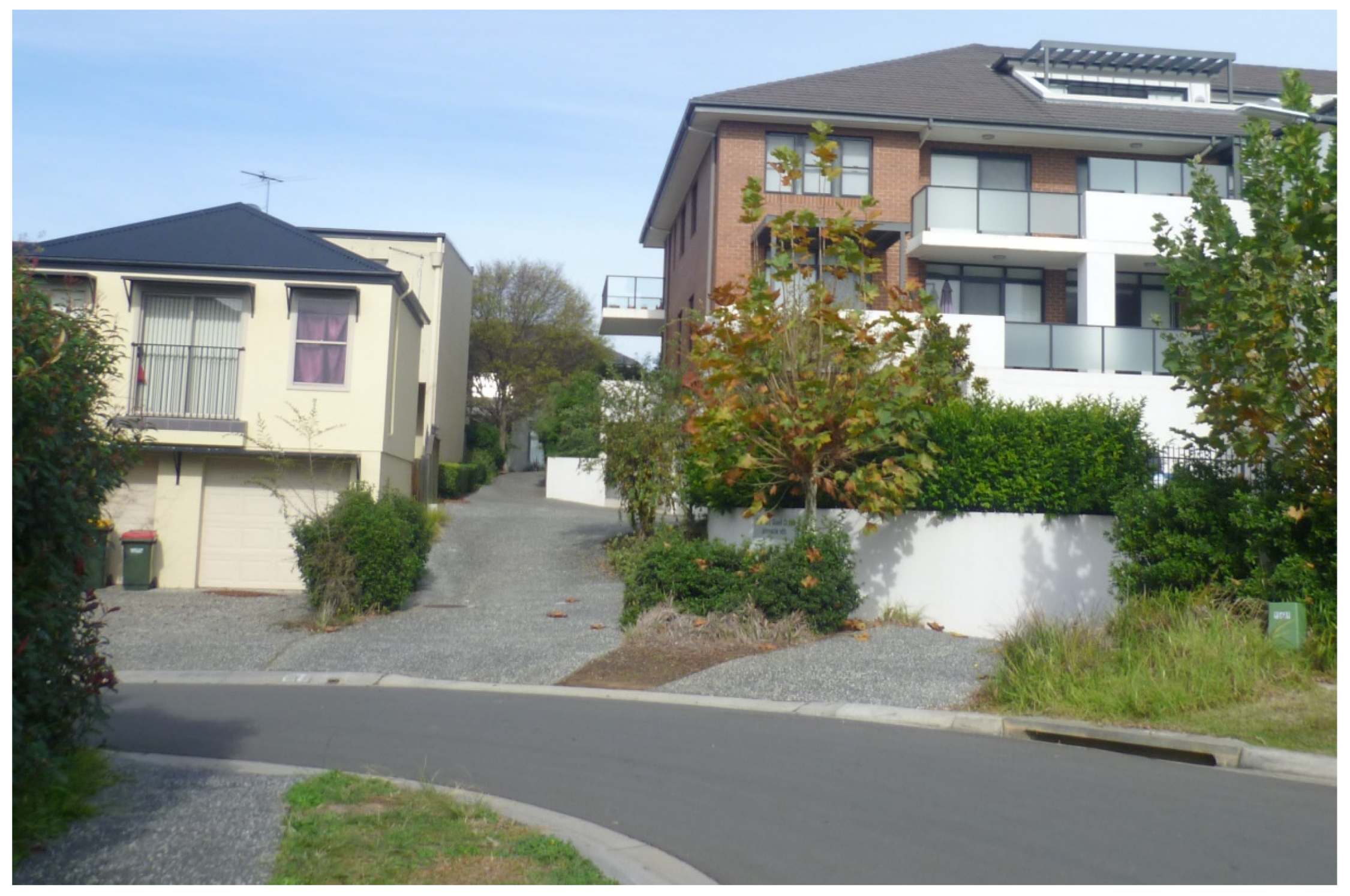
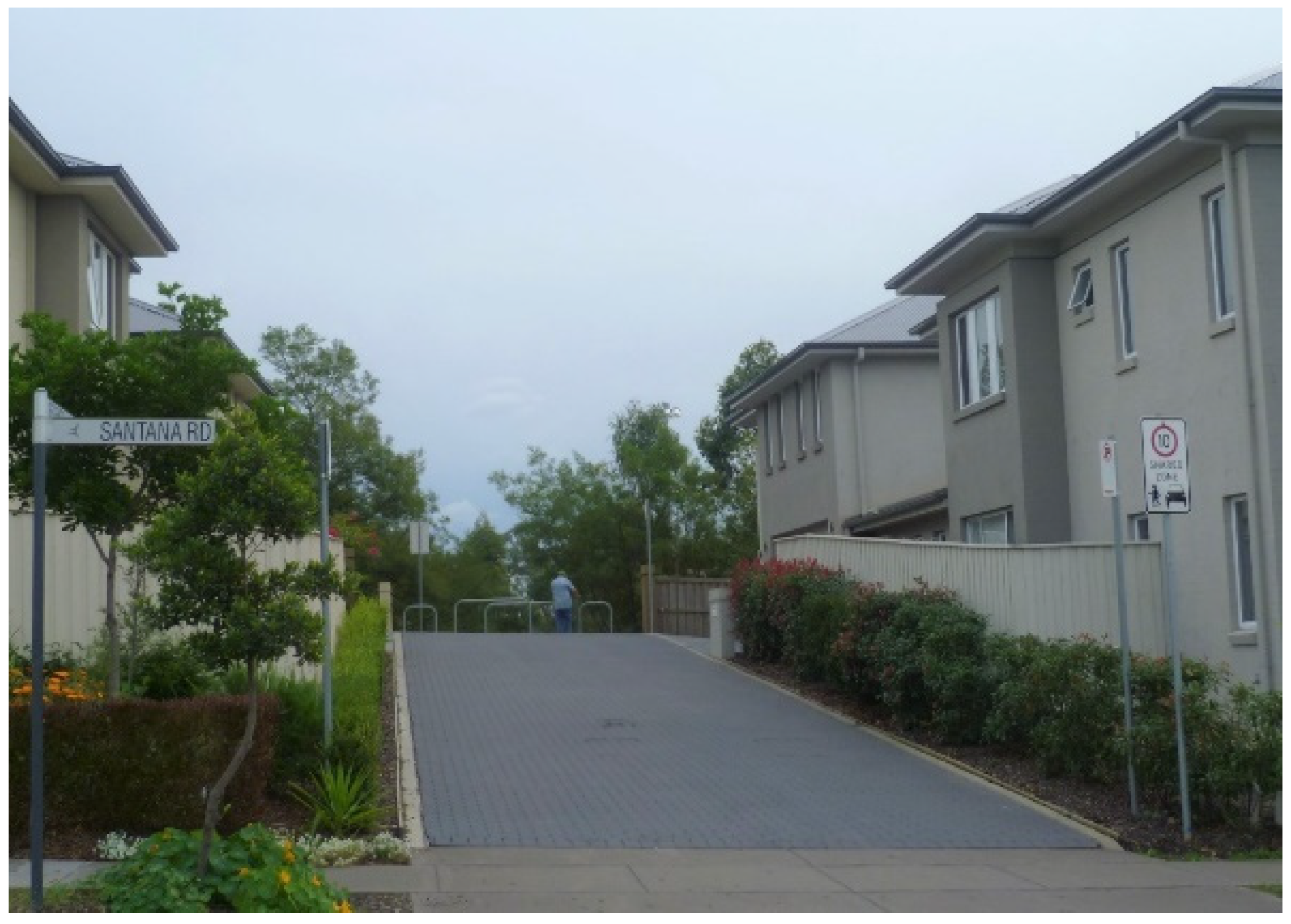
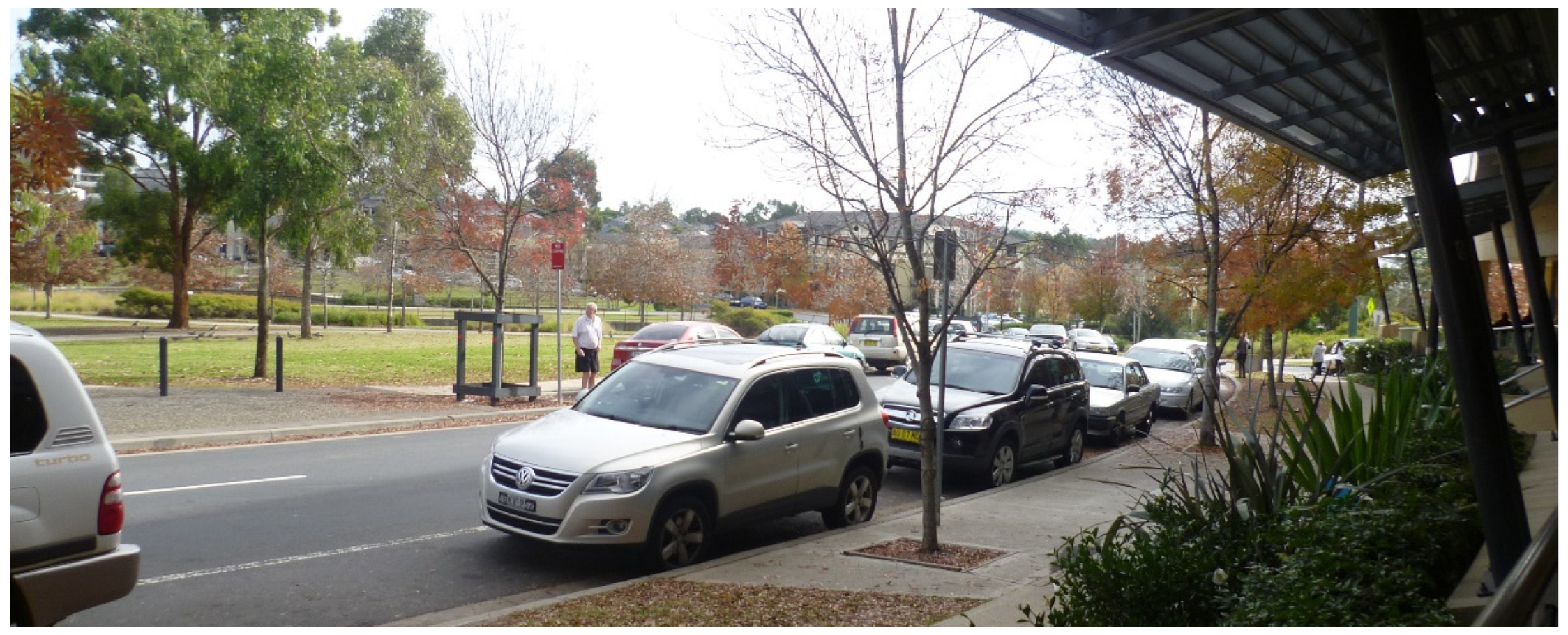

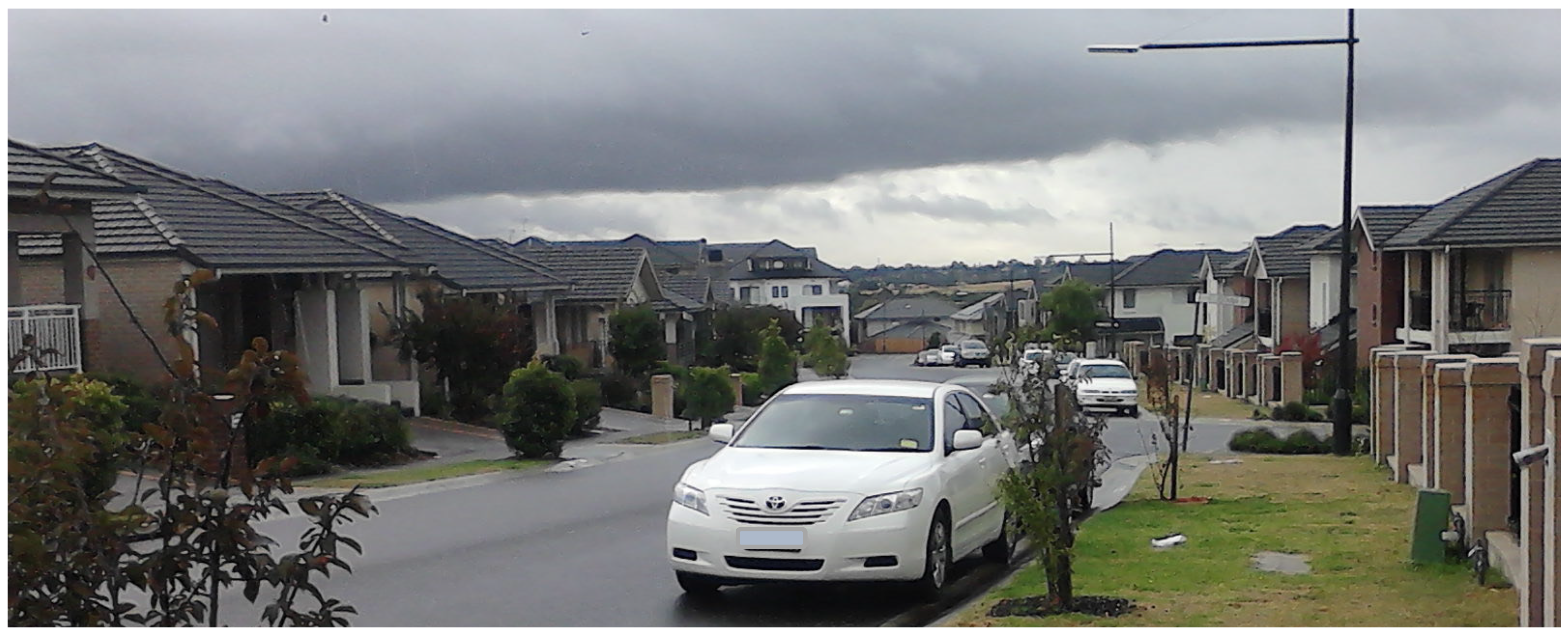

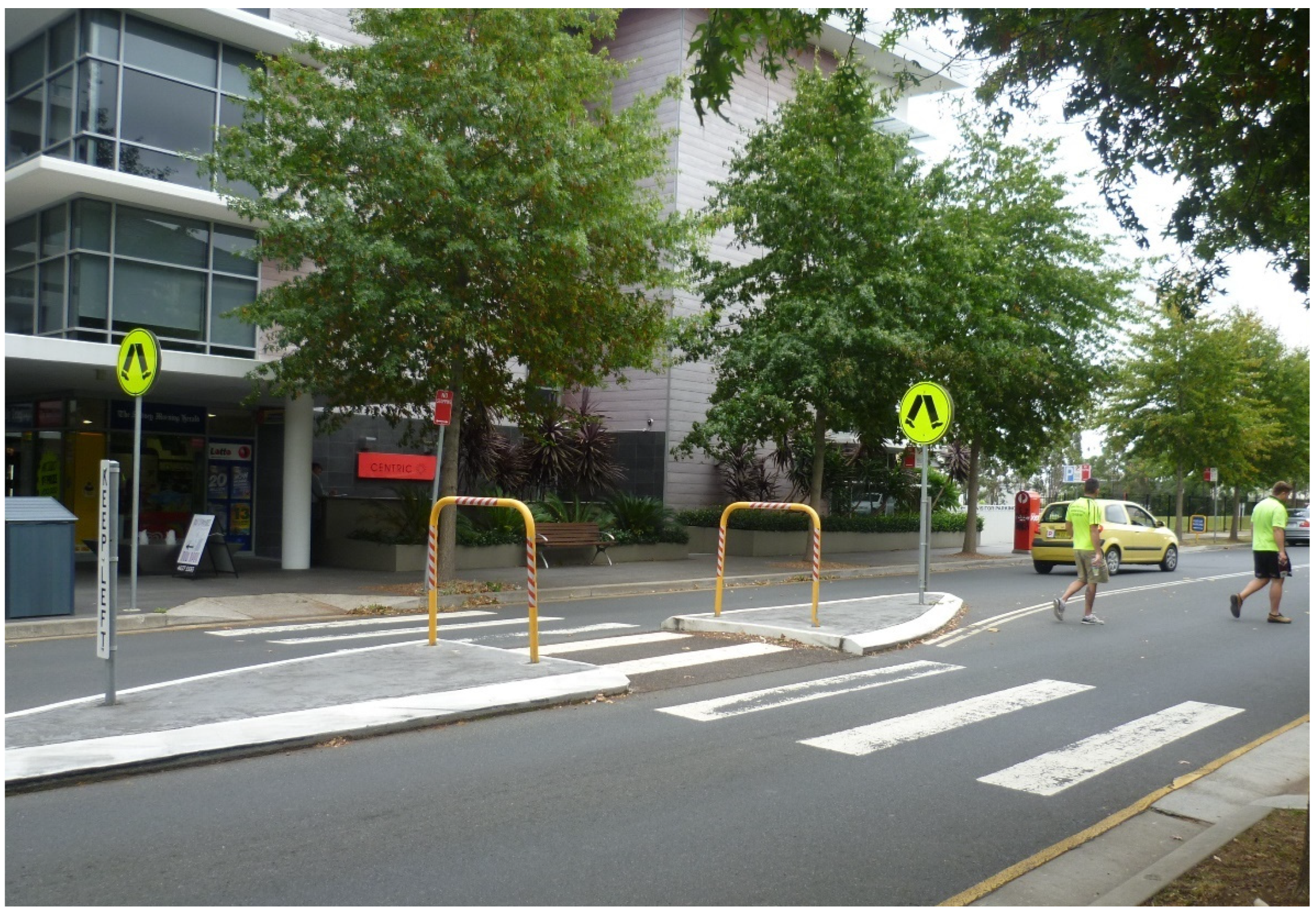
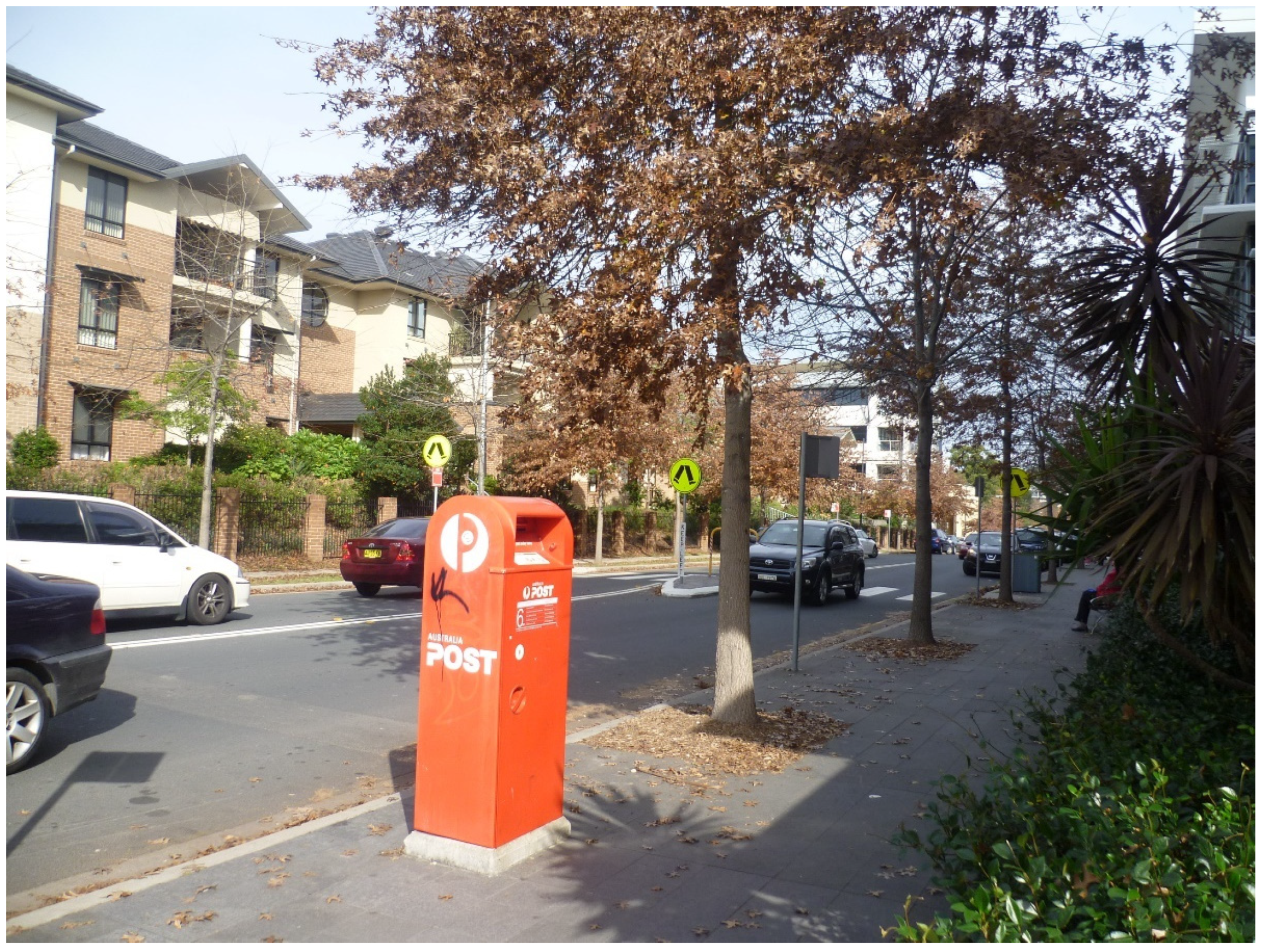
Disclaimer/Publisher’s Note: The statements, opinions and data contained in all publications are solely those of the individual author(s) and contributor(s) and not of MDPI and/or the editor(s). MDPI and/or the editor(s) disclaim responsibility for any injury to people or property resulting from any ideas, methods, instructions or products referred to in the content. |
© 2023 by the authors. Licensee MDPI, Basel, Switzerland. This article is an open access article distributed under the terms and conditions of the Creative Commons Attribution (CC BY) license (https://creativecommons.org/licenses/by/4.0/).
Share and Cite
Jones, A.; Parham, S. Living in an Age-Friendly Community: Evidence from a Masterplanned Development in Southwest Sydney. Int. J. Environ. Res. Public Health 2023, 20, 1312. https://doi.org/10.3390/ijerph20021312
Jones A, Parham S. Living in an Age-Friendly Community: Evidence from a Masterplanned Development in Southwest Sydney. International Journal of Environmental Research and Public Health. 2023; 20(2):1312. https://doi.org/10.3390/ijerph20021312
Chicago/Turabian StyleJones, Alasdair, and Susan Parham. 2023. "Living in an Age-Friendly Community: Evidence from a Masterplanned Development in Southwest Sydney" International Journal of Environmental Research and Public Health 20, no. 2: 1312. https://doi.org/10.3390/ijerph20021312
APA StyleJones, A., & Parham, S. (2023). Living in an Age-Friendly Community: Evidence from a Masterplanned Development in Southwest Sydney. International Journal of Environmental Research and Public Health, 20(2), 1312. https://doi.org/10.3390/ijerph20021312








